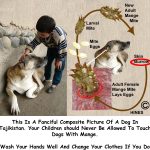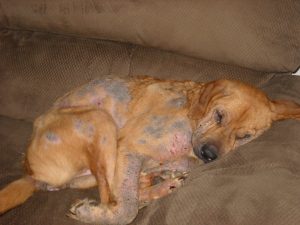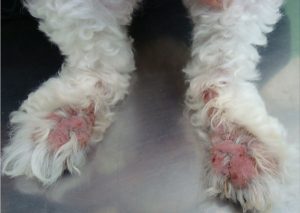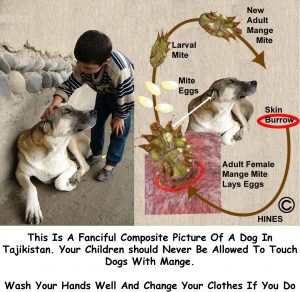Sarcoptic Mange In Your Dog “Scabies”
Ron Hines DVM PhD
 For The Other Kind Of Mange, Demodectic, Go Here
For The Other Kind Of Mange, Demodectic, Go Here
 Newest Mange Treatment Option Here
Newest Mange Treatment Option Here
What Causes Mange?
Two forms of mange are common in dogs. They are sarcoptic mange, the subject of this article, caused by Sarcoptes scabiei and demodectic mange caused by Demodex canis. Read about demodectic mange here. Cats can also become infected with sarcoptic mange. They also have a third type, notedric mange. Sarcoptic mange is sometimes called scabies. It infects a wide range of domestic and wild animals.
Sarcoptic mange is highly contagious between dogs – particularly young and stressed ones kept under less than ideal conditions. It is found all over the World. Sarcoptic mites are near-microscopic in size. The adults are eight-legged creatures, closely related to ticks. Their entire life cycle of three to four weeks is spent on the dog or some other host.
Female sarcoptic mites are twice as large as males – similar to the one in the illustration at the top of this page. Males stay on the pet’s skin surface. But female mites burrow into the upper layers of the skin forming long tunnels. Your pet’s reaction to this activity and products that the mites release cause intense itching, scratching, reddened streaks and skin inflammation.
The female mites periodically lay small clusters of eggs in their tunnels. These eggs hatch into immature larva that mature into “nymph” forms (with six legs). Female nymphs mature to create their own skin tunnels, more itching and more inflammation. Early on, itching and scratching are the only signs. But as the number of mites on your pet increases, its skin usually becomes very crusty, darkened and thickened. Hair is lost due to self trauma.
Dogs of any age can become infected, but as I mentioned, sarcoptic mange is most common in young animals.
How Did My Dog Catch Sarcoptic Mange?
Sarcoptic mange is usually spread by close contact between a dog that carries mites and one that does not. It’s method of spread is similar to that of head lice in children. Dogs that spread the infections often have little or no signs that they are infected. Sarcoptic mange can also be spread by contact with objects, such as blankets and quarters that have recently been used by infected animals. Mange mites do not generally survive off a host animal for more than 2-4 days.
Sarcoptic mange is usually spread where large numbers of poorly maintained dogs are maintained in crowded conditions – such as at animal shelters, boarding kennels and pet shops. It is also transferred at grooming salons through towels, clippers and improperly sanitized caging. Mother dogs in recovery or in long-term balance with the parasite often transmit it to their offspring. So, puppies from puppy mills and unsanitary breeders are also a major source of the disease.
What Signs Will I See If My Pet Has Sarcoptic Mange?
It is easiest for the mites to burrow into skin that has sparse hair. That, plus the fact that pets check new situations out with their head, makes the edges of the ears and the face prime areas for sarcoptic mange to begin. Elbows and tummies are also areas that become infected early. When they do, small red papules and welts in these areas are common. As the disease progresses and the number of mites multiply, the whole body is eventually infested with these parasites.
The intense irritation these mites produce, cause pets to scratch incessantly. I know of no other chronic skin problem that is as intensely itchy as sarcoptic mange. You can hear the pet scratching throughout the house. Oozing, raw skin often causes off-white crusts to form that are very typical for sarcoptic mange. You can see them on the edge of the dog’s ear in my illustration by clicking on this thumbnail image:
When they are present, the disease is unmistakable. However, not all pets develop these typical crusts and many pet owners have cleaned and treated the areas with over-the-counter medicines before giving up and bring them to a veterinarian.
Bacteria and yeast take advantage of this unhealthy situation and give the pet a strong, musty odor (seborrhea) and a look similar to this:
These secondary infections and mite debris also cause the lymph nodes that drain the skin to become enlarged. Pets often lose weight as well.
In long-standing cases, the pet’s skin may become thickened and over pigmented with folds and wrinkles, similar to this:  These are the cases with the greatest superficial lymph node enlargement, weight loss and general debility.
These are the cases with the greatest superficial lymph node enlargement, weight loss and general debility.
Do All Dogs Exposed To Sarcoptic Mange Mites Show These Signs?
No
Not all dogs that are exposed to sarcoptic mange mites develop severe disease. In some dogs, the mange mites remain very localized in their locations on the body (extremities like ears, tail and paws). In others the dog’s body keeps mange mite numbers very low and asymptomatic (no visible skin disease). In still others all mites are eventually destroyed by the dog’s immune system. A recent study in wolves showed that specific genes that canines inherit likely underlie these differences in mange severity. In 2020, blood samples collected over 25 years from specific wolves showed that wolves with the greatest genetic diversity (least inbred) were the most likely to eliminate mange mites without treatment or to develop only mild infestations. The most inbred wolves were the ones most likely to die from sarcoptic mange. Ask me for DeCandia2020.pdf
How Will My Veterinarian Determine If Sarcoptic Mange Is My Pet’s Problem?
Diagnosis of Sarcoptic mange relies on your veterinarian finding mites, or mite eggs and excrement on your pet. Sarcoptes is easiest to diagnose when crusts are still present on your pet’s skin. When these crusts are scraped from your pet and suspended in oil, mites are usually common and easy for your veterinarian to see using a microscope.
However, once a pet has been bathed and scrubbed free of crusts, locating mites can become quite difficult. It often requires several scrapings and close microscopic examination to find just one mite. In these cases, ingested mites can sometimes be found in the pet’s fecal material. An antibody test (ELISA test) has also been used to identify exposed pets.
In stubborn cases of itchy dogs, when skin scrapings have been negative; veterinarians may send off a skin biopsy for pathological examination. The type of inflammation that pathologists observe in these samples can be suggestive of a sarcoptic mange problem.
When mites cannot be found, many veterinarians still give pets medications that are known to cure mange. If the dog makes a dramatic recovery in 2-4 weeks, we know mange was the problem. The symptoms of sarcoptic mange are similar to that seen in food allergies and canine atopy (inhalant allergies). Giving an acaricide (a medication that kills mites) is a good way to help sort these causes out. It is particularly important to rule out sarcoptic mange before a pet is placed on an itch-suppressing dose of corticosteroid medication. Corticosteroids, given to a sarcoptic mange positive dogs, are likely to make the situation much worse because they weaken skin defenses (I think it is likely that more advanced anti-itch medications such as Apoquel® might do the same thing).
What Treatments Cure Mange?
I wrote this article primarily for dogs. If you have a pet of another species, such as a cat, do not use any of these products other than under the supervision of your veterinarian. The toxicity of these medications varies between species. Also, certain breeds of dogs (collies, herding dogs, etc.) are more sensitive to some of these compounds than to others. Many of these products will kill heartworm larva which can cause a reaction in heartworm-positive pets.
Be sure to read the next section on when those treatments are safe and when they are not
Luckily, numerous medications eliminate sarcoptic mange mites. They are much easier to kill than their cousins, demodectic mange mites. In olden days, oily products that plugged up the mite’s respiratory system were used. Old automotive motor oil was one of them. It should never be used.
Ivermectin
Ivermectin is routinely used to prevent heartworm disease. At a higher dose, It is very effective in curing sarcoptic mange too. Although it works rapidly, the pets will continue to itch for a while due to the remaining mite debris in their skin. Ivermectin is effective when given by injection or orally. Because it can be toxic in certain pets and certain situations, it should only be given in consultation with your veterinarian. When a spinosad – containing flea control product (e.g. Comfortis®) is used in your pet, the dose of ivermectin must be closely monitored or another product used. Spinosad is one of several chemicals that can make the effects of ivermectin too strong; read about others below. Ivermectin is not FDA-approved for use in eliminating mites. But it is commonly used for that purpose. Be sure your dog is not one of the breeds that are sensitive to ivermectin.
Selamectin (Revolution®)
This product works well to eliminate sarcoptic mites. The dose frequency to cure an infected dog is greater than the dose frequency suggested to prevent flea and heartworm infection. But at the recommended monthly dose, it would probably lessen the chances of your dog becoming infected with sarcoptic mange. It has been approved by the US FDA for this use, although its primary use is as a heartworm and flea control product.
Moxidectin (Advantage Multi®)
Advantage Multi appears effective in curing sarcoptic mange – although it is not US FDA approved for this use. It is sold as a heartworm and flea control product. I have seen the large animal moxidectin product (Detectomax®) used in animal shelter situations because of its lesser cost. But I know of no studies that confirm that it is safe or effective.
Amitraz (Mitaban®)
This product is used as a dip. It is primarily used to treat another form of mange, demodectic mange, but it is also effective in killing sarcoptic mange mites. To be effective, the pet must first be bathed well in a pet-friendly shampoo to remove crusts, debris and skin oil. This allows the amitraz to penetrate the skin to the level where the mites reside. Another dip, lime sulfur dip, is usually reserved for cats with notedric mange or very young puppies. Because we now have injectable, topical and oral medications that do not need to be in direct contact with the mites, mange dips are used much less frequently than they once were. Because of amitraz’s occasional toxicity and my concern for the health of my veterinary staff, I avoid using this product.
Are These Medications Safe For All Dogs With Mange?
No.
The majority of dogs that develop demodectic mange do just fine on these medications when they are given in the proper dose and at the proper interval.
But that is not always the case. In the case of ivermectin and similar drugs, very young dogs and old or frail dogs may not handle them well (at the standard dose). You see, ivermectin kills mites by disabling the mites nervous system. Most dogs have a gene pair that prevents ivermectin from entering the pet’s brain (penetrating the blood brain barrier) and doing damage. But in some dogs, that pair of genes (MDR1 aka ABCB1 genes) are defective. And in the old, frail or the very young dog, the barrier is weak. Ivermectin is part of a group of chemicals called avermectins. Those dogs are not only more prone to be sensitive to ivermectin; they tend to be sensitive to the entire family of avermectins which includes many of the drugs veterinarians use to treat parasites. Certain dog breeds are known for their tendency to have these defective genes. They include the herding dogs: collies, border collies, Australian shepherds, as well as mixed breed dogs that are part those breeds. What I gave you is not a complete list of all of them.
The same sensitivity we sometimes see in those breeds also can occur in any breed or mix if the dose given is too large. As a rule of thumb, those drugs are more apt to cause a problem when they are given orally or by injection and less likely to do so when massaged in small amounts into the skin of affected areas. But that cannot be entirely relied upon. Dogs can be tested to see if they have this defective gene.
If your dog (or cat – cats are much more sensitive to these drugs!) has a bad reaction to ivermectin or its sister medications the most common signs are ataxia (a drunken gait), confusion, general weakness, salivation, vomiting, trembling, dilated pupils, loss of vision, and, in severe cases, seizures and coma.
If the medication was applied topically to the pet’s body. While wearing gloves, wash it off immediately with a warm solution of Dawn dish soap with many rinses. Later, change your clothes. Be sure the pet’s head and breathing are supported and get the pet to the vet ASAP. Dry the dog well with paper towels and keep it warm if it is chilled. (If it has had recent seizures, it may actually have a fever. Also heating pads and lamps are dangerous when a dog is too mentally confused to move away.) There is no antidote for this problem, but your vet will give the pet life-sustaining support and, hopefully, it will fully recover.
Of the mite-destroying medications, amitraz dips or spot treatments, although it too can cause problems in the very young, the debilitated (weak) or when used incorrectly.
Bravecto ® (fluralaner) an oral flea and tick medication for dogs is said to have been effective in curing demodectic mange; but I have no experience using it to treat mange.
Although moxidectin is in the same drug family as ivermectin, some veterinarians use it, combined with imidacloprid (Advantage Multi®) to treat mange successfully – even in dogs with the MDR1 aka ABCB1 gene mutation. I use that product on my Labrador, Maxx, monthly to prevent heartworms and fleas – but never in a specific attempt to cure mange.
In the case of the ivermectin family of medications; when a reaction is mild or minimal, sometimes just lowering the dose is sufficient to continue treatment. Certain medications the dog might be receiving concurrently (spinosad/Comfortis ®, antifungals medications like itraconazole and ketoconazole, certain antibiotics, corticosteroids, Apoquel®/oclacitinib, etc.) can make a bad reaction to the avermectins more likely
Are There Other Things That Might Help My Pet Recover?
Yes.
Not only are nutritionally deprived pets more susceptible to severe mite infestations, those already infected need of excellent nutrition to speed their recovery. So, a premium pet food brand with additional antioxidant, trace mineral and vitamins or a supplement of those ingredients.
How Can I Prevent My Pet From Catching This Disease?
Monthly selamectin topical drops will prevent sarcoptic mange. Some of the other topical flea and heartworm control avermectin products will probably also prevent sarcoptic mange – but they are not currently approved for that use in the United States.
Sarcoptic mange usually requires close contact to pass from one animal to another. The mites are quite restricted in their ability to move over distance and do not survive long when they are not on a host animal. So, the same things you would do to avoid catching the flu will minimize the risk of your pet contracting sarcoptic mange. Avoid bringing your pet in contact with large groups of dogs, particularly younger ones and pets that are kept in group situations. When you must introduce your pet to high-risk activities, mist them off with a topical pyrethrin-based flea spray when you get home. If this happens frequently, consider using Revolution® or an equivalent selamectin product monthly.
Can Other Animals Or People Catch Sarcoptic Mange?
There are a number of sarcoptic mites. The ones that affect dogs are slightly different from the ones that affect other non-canine animals. When a mite jumps to the wrong type of animal, it will live on that animal for a time. We used to think that these wrong-host infections die out of their own accord. However, some cases in cats appear to be due to the sarcoptic mite normally found on dogs.
If you associate with a pet that has sarcoptic mange, you may begin to itch. These human infections with dog sarcoptic mites are temporary (1-2 wks) – but they are quite itchy and unpleasant. They commonly form on the arms, neck and torso near elastic bands that give the parasite traction. So be sure to use gloves when you handle an infected pet and put all your garments in a hot wash cycle when you finish tending to your pet. The exceptions are folks with weakened immune systems – diseases like AIDS, cancer, autoimmune diseases or chemotherapy. In those people, sarcoptic mange infections can be more severe.
When cats become infected from infected dogs in the home, the infection is usually temporary.
How Long Will Sarcoptic Mange Mites Survive Off My Dog?
When you treat your pet for sarcoptic mange, wash all washable materials in a hot water washer cycle to kill any mites that may be present in them. Include the pet’s collar and tags or dip them in rubbing alcohol and let them dry. Things that cannot be washed or sanitized, need to sit for a week before they are used again. Some veterinary texts and websites say these mites can survive up to three weeks off the dog. But the only study I know about found that 2-3 days was the longest they survive off their host at normal room temperature. In another, 10 minutes at 122 F (50 C) killed them all.
Once your veterinarian knows what the problem is, sarcoptic mange in your dog “scabies” is a much easier problem to cure than a good deal of the health issues dogs face.
You are on the Vetspace animal health website
Visiting the products that you see displayed on this website help pay the cost of keeping these articles on the Internet.

